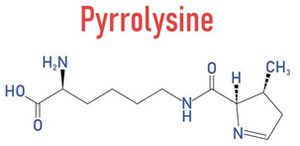Pyrrolysine
At the turn of the 1970s and 1980s, the twenty-first - selenocysteine (Sec) - and recently the twenty-second, pyrrolysine (Pyl) were added to the classically coded twenty amino acids . Unlike all previous amino acids, triplets are encoded, which normally serve as signals to terminate translation (see genetic code ). Specifically, the triplet UGA serves for the incorporation of selenocysteine and UAG for the incorporation of pyrrolysine.
The occurrence of pyrrolysine (Pyl) is so far limited to members of the Methanosarcinaceae family of archaebacteria and the bacterium Desulfitobacterium hafniense . The involvement of pyrrolysine in the metabolism of these organisms is related to their exceptional ability to use methylamines as an energy source. They do this through the enzymes methylaminomethyltransferases , and for their successful synthesis it is necessary that one UAG triplet located in the reading frame of their mRNA is read not as a termination signal , but as a signal for pyrrolysine incorporation. In addition, D. hafniense encodes a system that incorporates selenocysteine into proteins , so this bacterium is the only known organism that uses all 22 amino acids in photosynthesis.
Links[edit | edit source]
Related Articles[edit | edit source]
Source[edit | edit source]
At the request of the author and with the permission of the publisher, adapted from Jonák J: RNA in proteosynthesis. Coding for selenocysteine and pyrrolysine. Živa 5/2007, 195-198.
- JONÁK, J. RNA in proteosynthesis. Genetic code and preparation of aminoacyl–tRNA. Alive [online]. 2007, year 2007, vol. 5/2007, pp. 195-198, also available from <http://ziva.avcr.cz/files/ziva/pdf/rna-v-proteosynteze-geneticky-kod-a-priprava-amino.+pdf >. ISSN 0044-4812.
| Amino acids | |
|---|---|
| essential proteogenic amino acids | Arginine • Histidine • Lysine • Valine • Leucine • Isoleucine • Methionine • Phenylalanine • Threonine • Tryptophan |
| non-essential proteogenic amino acids | • Kyselina Alanine Arginine • Asparagine • Cysteine • Glutamine • Glycine • Kyselina asparagová • glutamová • Proline • Pyrrolyzin • Tyrosine • Selenocysteine • Serine |
| non-coding amino acids | Hydroxyprolin • Hydroxylyzin |
| Portal: Biochemistry | |

